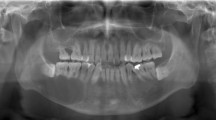Abstract
Dentigerous cysts, also known as follicular cysts, are among the most common developmental cysts of the gnathic bones. The majority of cases are clinically asymptomatic and discovered incidentally on panographic radiographs during routine dental care. The cyst appears as a radiolucency, classically unilocular, associated with the crown of an unerupted or impacted tooth. Usually diagnosed in the 2nd–3rd decade, third molars of the mandible are the most commonly affected teeth. Histologically, dentigerous cysts demonstrate a fibrous or fibromyxoid connective tissue wall lined by squamous epithelium, classically lacking rete ridges. Inflammation may introduce histologic changes, however. The differential diagnosis includes hyperplastic dental follicle, periapical or radicular cyst, unicystic ameloblastoma, odontogenic keratocyst, and other odontogenic cysts and tumors. While the findings are generally classic and pose no diagnostic dilemma, the diagnosis is best made in the context of the appropriate clinical and radiographic setting. Submitted tissue with a lack of history, to include a detailed relationship with the affected tooth, may result in misdiagnosis and subsequent confusion for the clinician. So, despite its simple features, dentigerous cysts are not uncommonly mischaracterized. Therefore a review of a classic case of dentigerous cyst is presented.




Similar content being viewed by others
References
Narang RS, Manchanda AS, Arora P, Randhawa K. Dentigerous cyst of inflammatory origin—a diagnostic dilemma. Ann Diagn Pathol. 2012;16:119–23.
Thompson LDR, Bishop JA. Head and neck pathology. 3rd ed. Amsterdam: Elsevier; 2018.
El-Naggar AK, Chan JKC, Grandis JR, Takata T, Slootweg PJ, editors. WHO classification of head and neck tumours. 4th ed. Lyon: IARC; 2017.
Fonseca RJ, editor. Oral and maxillofacial surgery. 3rd ed. Amsterdam: Elsevier; 2018.
McMillan MD, Smillie AC. Ameloblastomas associated with dentigerous cysts. Oral Surg Oral Med Oral Pathol. 1981;51:489–96.
Bodner L, Manor E, Shear M, van der Waal I. Primary intraosseous squamous cell carcinoma arising in an odontogenic cyst—a clinicopathologic analysis of 116 reported cases. J Oral Pathol Med. 2011;40:733–8.
Eversole LR, Sabes WR, Rovin S. Aggressive growth and neoplastic potential of odontogenic cysts with special reference to central epidermoid and mucoepidermoid carcinomas. Cancer. 1975;35:270–82.
Thompson LDR. Dentigerous cyst. Ear Nose Throat J. 2018;97:57–57.
Lin HP, Wang YP, Chen HM, Cheng SJ, Sun A, Chiang CP. A clinicopathological study of 338 dentigerous cysts. J Oral Pathol Med. 2013;42:462–7.
Layfield LJ, Factor RE, Jarboe EA. Clinician compliance with laboratory regulations requiring submission of relevant clinical data: a one year retrospective analysis. Pathol Res Pract. 2012;208:668–71.
Daley TD, Wysocki GP. The small dentigerous cyst: a diagnostic dilemma. Oral Surg Oral Med Oral Pathol Oral Radiol Endodontol. 1995;79:77–81.
Fowler CB, Brannon RB, Kessler HP, Castle JT, Kahn MA. Glandular odontogenic cyst: analysis of 46 cases with special emphasis on microscopic criteria for diagnosis. Head Neck Pathol. 2011;5:364–75.
Chrcanovic BR, Gomez RS. Odontogenic myxoma: an updated analysis of 1,692 cases reported in the literature. Oral Dis. 2019;25:676–83.
Funding
This study has no funding.
Author information
Authors and Affiliations
Corresponding author
Ethics declarations
Conflict of interest
Both authors declare that there is no conflict of interest.
Disclaimer
The opinions and assertions expressed herein are those of the authors and are not to be construed as official or representing the views of the Department of the Navy, Department of Defense, or the U.S. Government. We are military service members of the United States government. This work was prepared as part of my official duties. Title 17 U.S.C. 105 provides that ‘copyright protection under this title is not available for any work of the United States Government.’ Title 17 U.S.C. 101 defines a U.S. Government work as work prepared by a military service member or employee of the U.S. Government as part of that person's official duties.
Ethical Approval
This article does not contain any studies with human participants or animals performed by any of the authors.
Additional information
Publisher's Note
Springer Nature remains neutral with regard to jurisdictional claims in published maps and institutional affiliations.
Rights and permissions
About this article
Cite this article
Austin, R.P., Nelson, B.L. Sine Qua Non: Dentigerous Cyst. Head and Neck Pathol 15, 1261–1264 (2021). https://doi.org/10.1007/s12105-021-01327-3
Received:
Accepted:
Published:
Issue Date:
DOI: https://doi.org/10.1007/s12105-021-01327-3




